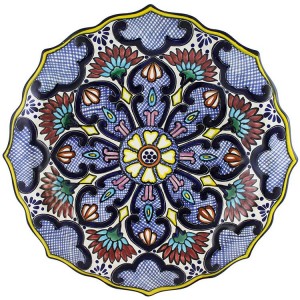 Talavera pottery is an art, historically linked to certain spaces like the kitchen, churches, convents, facades, and interiors of houses. This art that is essential as sculpture, has also an internal space; that of imaginary, represented over its surface; this spaces conform a world where reality and fantasy communicate, where the hands that create, buy and sell ,combine with the hands that paint the forms of their dreams into an object. This is the world of Talavera Poblana, another world in our world.
Talavera pottery is an art, historically linked to certain spaces like the kitchen, churches, convents, facades, and interiors of houses. This art that is essential as sculpture, has also an internal space; that of imaginary, represented over its surface; this spaces conform a world where reality and fantasy communicate, where the hands that create, buy and sell ,combine with the hands that paint the forms of their dreams into an object. This is the world of Talavera Poblana, another world in our world.
Talavera ceramic is made in several parts of Mexico, but official Talavera is only produced in Puebla. The Talavera produced in certain workshops in Puebla is now officially designated, recognized and protected by the Government of Mexico. These Talavera manufacturers must follow a complex and strict technical fabrication process dating from the 16th Century and use only clay from a few approved clay sites in the Puebla area.
Since the mineral pigments needed to produce the color blue were very expensive, this color was reserved for the finest ceramic. Talavera buyers could easily differentiate the quality of fine ceramic from the one of lesser quality. During the 18th Century the Talavera artisans started to broaden the designs of their ceramic by using more colors, like green, mauve and yellow, in addition to the blue tones that were very popular in the 16th and 17th Centuries.
Thanks to the artistic skills and the high quality of the clays, the Talavera form Puebla has achieved high quality and beauty. In the centuries XIX and early XX it became common for wealthy families in Mexico to have extensive collection of talavera dinner sets and decorations. Since then, it has been treasured and appreciated by collectors and admirers all over Mexico and in many other parts of the world.
